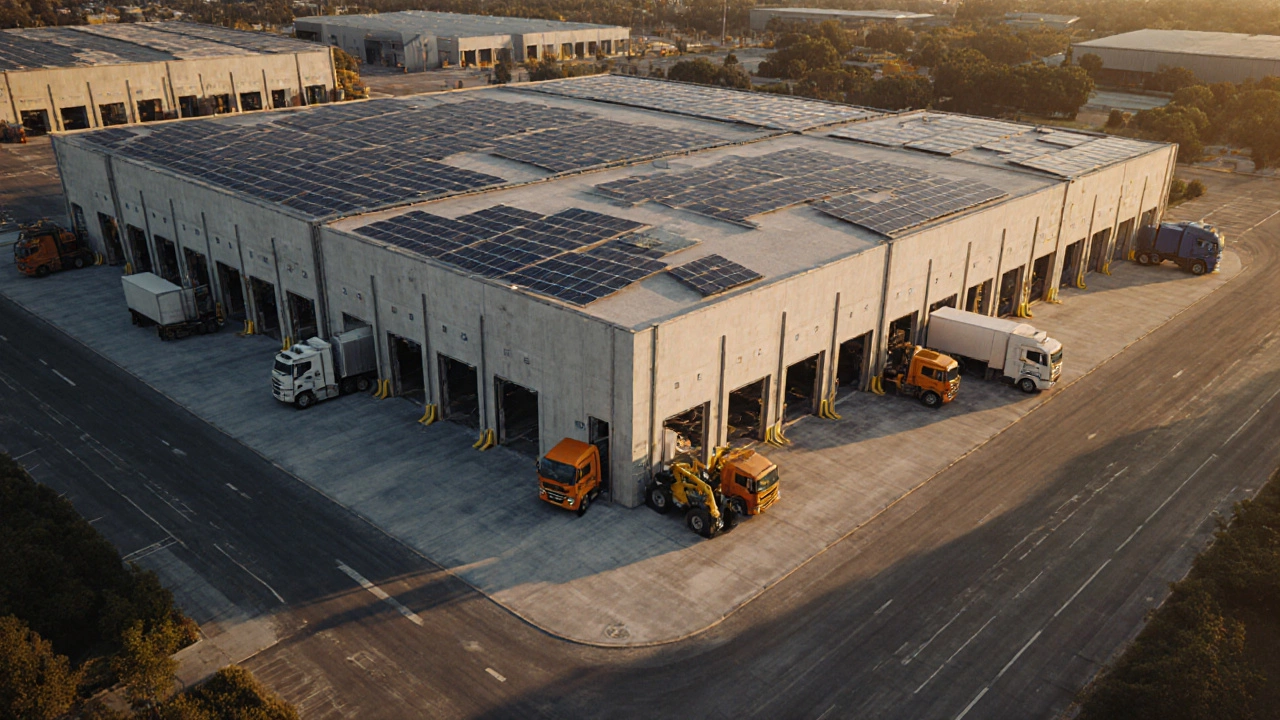Commercial Property Insights: What Every Investor Should Know
If you’re looking at buying, selling, or renting commercial space, you probably have a lot of questions. How does ROI work? What market signs should you watch? Which property types give the best cash flow? This guide cuts through the jargon and gives you straight‑up answers you can use right now.
Why commercial property matters
Commercial real estate isn't just about big office towers or malls. It includes anything from a small shop front to a warehouse that stores goods. The big draw is income. Instead of hoping a house appreciates over years, a well‑run commercial spot can generate rent every month, helping you cover costs and build profit faster.
Investors love the predictability of lease contracts. Tenants often sign three‑ to five‑year leases, which means steady cash flow. Plus, commercial leases usually put more responsibility on the tenant for maintenance, utilities, and insurance. That can lower your ongoing expenses compared to a residential rental.
Key factors to consider before you buy
Location matters, but not in the same way it does for homes. A downtown office might be priceless for a tech firm, while a suburban warehouse could be gold for a logistics company. Look at traffic patterns, nearby businesses, and future development plans. A new subway line or highway can boost a property's value quickly.
Understand the numbers. Start with the cap rate – the net operating income divided by the property price. A 6% cap rate is generally solid, but it varies by city and property type. Also, calculate cash‑on‑cash return, which shows how much money you earn on the cash you actually invested.
Tenant quality is critical. A long‑term lease with a reputable company reduces risk. Check the tenant’s credit rating and the lease terms. A triple‑net lease (NNN) is common in commercial deals; it shifts most costs to the tenant, making your cash flow more predictable.
Know the market cycle. During a recession, office space demand may dip, but industrial and logistics properties often stay strong. Some investors even hunt for deals in a downturn, betting that prices will rise when the economy recovers.
Financing options differ. Commercial loans usually require a larger down payment (20‑30%) and have shorter terms than residential mortgages. Some buyers use a cash‑out refinance to pull equity from an existing property and fund a new purchase. Make sure the loan terms match the expected cash flow.
By looking at these factors, you can spot opportunities early and avoid common traps. For instance, buying a property with a high cap rate sounds tempting, but if the building needs major repairs, your actual return could drop dramatically.
Finally, keep an eye on emerging trends. Co‑working spaces, data centers, and e‑commerce‑driven warehouses are reshaping demand. Investing in a property that can adapt to new uses—like adding loading docks or flexible interior walls—adds long‑term value.
Commercial property can be a powerful wealth‑building tool when you focus on income, location, and tenant quality. Use the simple metrics above, stay aware of market shifts, and you’ll be better equipped to make decisions that pay off.
How to Get a Commercial Property Valuation: A Clear Step-by-Step Guide
by Arjun Mehta Nov 17 2025 0 Commercial PropertyLearn how to get an accurate commercial property valuation in Australia. Understand the methods, what valuers look for, common mistakes, and how to prepare your property for the best possible outcome.
READ MOREWhat Type of Commercial Property Is Most Profitable in 2025?
by Arjun Mehta Nov 16 2025 0 Commercial PropertyIn 2025, industrial warehouses, self-storage, and medical offices are the most profitable commercial properties in Melbourne. Learn why these types outperform retail and offices, and where to find the best deals.
READ MOREWhich Bank Has the Lowest Interest Rate on Commercial Property in Australia?
by Arjun Mehta Nov 8 2025 0 Commercial PropertyFind out which banks offer the lowest interest rates on commercial property loans in Australia in 2025, how rates are set, and how to get the best deal based on your property and financial situation.
READ MORETop Websites to Find Commercial Property Listings in 2025
by Arjun Mehta Oct 24 2025 0 Commercial PropertyDiscover the top commercial property websites for 2025, compare features, fees, and coverage, and learn how to use them effectively to find your next investment.
READ MOREHow to Sell a Commercial Property: Step‑by‑Step Guide
by Arjun Mehta Oct 22 2025 0 Commercial PropertyA step‑by‑step guide on how to sell a commercial property, covering valuation, marketing, negotiation, taxes, and closing tips for Australian owners.
READ MOREHow to Calculate Commercial Property Value: A Step‑by‑Step Guide
by Arjun Mehta Oct 18 2025 0 Commercial PropertyLearn how to calculate commercial property value with step‑by‑step methods, data sources, and common pitfalls for investors and owners.
READ MOREIs 2 Percent Cash Back a Lot for Commercial Property Sale Deals?
by Arjun Mehta Jun 18 2025 0 Commercial PropertyWondering if a 2 percent cash back offer is a game-changer when buying or selling commercial properties? This article breaks down what 2 percent means in real dollar terms and compares it with other industry deals. We’ll dig into why sellers and buyers see these offers pop up, and when this rebate might tip the scales for your deal. Find out if this cash back could really impact your bottom line, and get practical tips before you sign that dotted line. No filler, just real-world advice.
READ MOREGood Cash Flow on a Rental Property: What You Really Need to Know
by Arjun Mehta Jun 12 2025 0 Commercial PropertyWondering what makes for good cash flow on a rental property? This article breaks down what terms like 'good cash flow' actually mean, why it's different for every investor, and what numbers you should look at before buying. We'll share straightforward tips for running the numbers, show you how to spot red flags, and explain some practical ways to boost your returns. By the end, you'll have a real-world grip on how to judge cash flow and make smarter commercial property moves.
READ MORECommercial Real Estate in a Recession: What Actually Happens?
by Arjun Mehta Jun 7 2025 0 Commercial PropertyWhen the economy stumbles and businesses tighten their belts, the commercial real estate market doesn’t come out unscathed. This article explains what really happens to office buildings, retail spaces, and warehouses during a recession, and how it shakes up prices, demand, and sales strategies. We’ll break down the ripple effects for both buyers and sellers, plus share some unexpected opportunities. If you’re thinking about buying, selling, or holding on to commercial property, you’ll find real, actionable advice here. No jargon—just the facts you actually need.
READ MORECommercial Property: What Counts as a Good Return on Investment?
by Arjun Mehta Jun 1 2025 0 Commercial PropertyFiguring out what makes a 'good return' when buying or selling commercial property isn't as clear-cut as you might think. This article spells out what counts as a strong ROI in different markets and types of commercial assets. You'll learn how investors calculate ROI, what numbers to look for, and what pitfalls to dodge. We'll also check out how market shifts can flip your returns in surprising ways. Whether you’re a first-timer or a seasoned investor, this guide will help shape your expectations and choices.
READ MORECommercial Real Estate: Why Skipping This Investment Might Be the Smart Move
by Arjun Mehta May 24 2025 0 Commercial PropertyThinking about putting your money into commercial real estate? There are reasons to hold back. This article breaks down the risky side of investing in offices, shops, or warehouses, including hidden costs and the headaches of managing tenants. Get real stories about market changes, liquidity problems, and how economic swings can sting investors. Make sure you know what you’re getting into before you commit your cash.
READ MORERule of Three Commercials: The Secret Sauce in Selling Commercial Property
by Arjun Mehta May 8 2025 0 Commercial PropertyThe rule of three commercials is a simple yet powerful trick in commercial property sales that smart sellers use to boost their chances. It's not some buzzword – it's a practical method that gets actual results. This article breaks down how the rule works, why it matters, and how property owners and agents can use it to score better deals. You'll find out about the psychology behind it, real-life examples, and mistakes to avoid. If you're thinking of selling commercial property, miss this strategy and you could leave money on the table.
READ MORE










